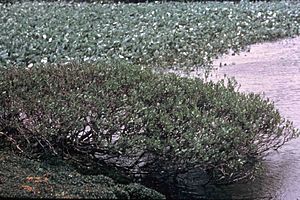Barren-ground willow facts for kids
Quick facts for kids Barren-ground willow |
|
|---|---|
 |
|
| Scientific classification | |
| Genus: |
Salix
|
| Species: |
brachycarpa
|
The Salix brachycarpa is a type of flowering plant. It belongs to the willow family. People often call it the barren-ground willow. Other names are small-fruit willow or shortfruit willow. This plant is a small shrub that grows in many different places.
Contents
Where Does Barren-Ground Willow Grow?
This willow plant is originally from North America. You can find it across most of Alaska. It also grows in western and northern Canada. In the United States, it lives in the Rocky Mountains. You can see it as far south as Colorado. It also grows in the Sierra Nevada mountains in California.
Habitats of the Barren-Ground Willow
Salix brachycarpa likes many kinds of places. It grows in coniferous forests and high mountain areas. You can often find it near rivers and streams. It also likes wet places like bogs, swamps, and moraines. It is common on floodplains, where it grows with other willows. This plant can even grow on special soils like serpentine barrens. It also likes salt marshes and salt flats. It can quickly grow in wet areas that have recently been cleared.
What Does Barren-Ground Willow Look Like?
The Salix brachycarpa is usually a short shrub. It can sometimes grow flat along the ground. It usually reaches about 1.5 meters (5 feet) tall. The stems can be a bit hairy. Younger branches might be very woolly. The leaves are also usually hairy. Their undersides often feel woolly.
How Barren-Ground Willow Reproduces
This willow species is dioecious. This means that male and female parts are on separate plants. The flowers grow in a cluster called a catkin. These catkins can be up to 5 centimeters long. The plant makes tiny, soft seeds. These seeds can only grow for a few days. But they can sprout very quickly, sometimes in just 12 hours.
Types of Barren-Ground Willow
There are at least two main types, or varieties, of this willow.
- Salix brachycarpa var. brachycarpa is the most common type.
- Salix brachycarpa var. niphoclada is known as the arctic type.
- Salix brachycarpa var. psammophila is a special type. It only grows in the sand dunes of Lake Athabasca in northern Saskatchewan, Canada.
How Barren-Ground Willow Is Used
This willow is important for wildlife. It also helps with land recovery.
Food for Animals
In interior Alaska, Salix brachycarpa is a food source for moose. It has been planted to help bring back moose habitat. This was done in the Alaska North Slope area.
Helping the Land Recover
This willow is also used in revegetation projects. These projects help new plants grow on disturbed land. It can also be planted to act as a windbreak. This helps protect other plants from strong winds.
Popular in Gardens
Salix brachycarpa is one of the few North American willows grown for sale. The type called S. brachycarpa 'Blue Fox' is very popular. People like it for its blue-gray leaves. They also like that it stays small, growing to about 1 meter (3 feet) tall.
Traditional Uses by Native Americans
Native Americans used parts of willows. This included the barren-ground willow. They used it for medicine. They also used it for basket weaving. Willows helped them make bows and arrows. They even used them to build traps for animals.
See also
 In Spanish: Salix brachycarpa para niños
In Spanish: Salix brachycarpa para niños

